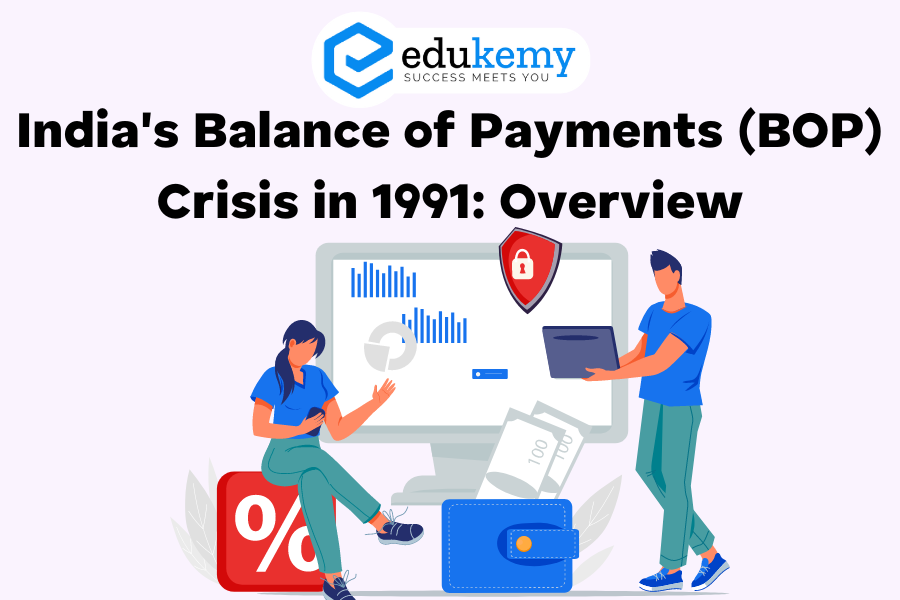
Background: In the early 1990s, India faced a significant Balance of Payments (BOP) crisis driven by various factors, including the Gulf War and cumulative economic issues. The crisis had severe implications for India’s foreign exchange reserves and international creditworthiness.
Contents
- 1 FAQs
- 1.1 Q: What triggered India’s Balance of Payments (BOP) Crisis in 1991?
- 1.2 Q: How did India attempt to address the BOP Crisis in 1991?
- 1.3 Q: What were the key consequences of India’s BOP Crisis in 1991?
- 1.4 Q: What were the long-term effects of the BOP Crisis on India’s economy?
- 1.5 Q: How did the international community respond to India’s BOP Crisis in 1991?
- 2 In case you still have your doubts, contact us on 9811333901.
Factors Contributing to the Crisis:
- Crude Oil Dependency:
- India heavily relied on crude oil imports.
- Geopolitical disturbances, such as the Iraq crisis, led to a spike in crude oil prices, elevating the import bill.
- Tourism Decline:
- The Gulf War and geopolitical tensions adversely affected tourism, reducing foreign exchange earnings.
- International Rating Downgrades:
- India faced downgrades from international rating agencies, affecting its creditworthiness.
- Non-Resident Indian (NRI) Deposits:
- Substantial outflow of deposits held by NRIs further exacerbated the crisis.
Dealing with the Crisis:
- Gold Pledging:
- To meet short-term debt servicing obligations, India had to pledge gold in May and July 1991.
- Borrowing Measures:
- India sought foreign currency through India Development Bonds and the Foreign Exchange Immunity Scheme, aimed at attracting back illegal foreign currency held abroad by resident Indians.
- IMF-Sponsored Bailout:
- India sought a bailout from the International Monetary Fund (IMF) to address the crisis.
Recovery Measures:
- Devaluation of Rupee:
- The rupee was devalued, aligning it closer to market value. This move aimed to boost exports by making them more competitive.
- Structural Reforms:
- Structural reforms were initiated to put the economy on a competitive path and open it to globalization.
- These reforms marked progress towards market orientation, attracting international investors.
- Overcoming BOP Pressures:
- Over time, the Indian economy recovered, with exports growing post-devaluation.
- Foreign inflows started to pick up, alleviating BOP pressures.
Conclusion: The BOP crisis of 1991 prompted significant policy changes, including devaluation, structural reforms, and opening up the economy. These measures not only stabilized the BOP but also set the stage for India’s economic liberalization and globalization in subsequent years. The crisis was a turning point that ushered in transformative reforms to ensure the country’s economic resilience and competitiveness on the global stage.
FAQs
Q: What triggered India’s Balance of Payments (BOP) Crisis in 1991?
India’s BOP crisis in 1991 was primarily triggered by a combination of factors including a burgeoning trade deficit, mounting external debt, dwindling foreign exchange reserves, and a severe economic slowdown. Structural issues such as inefficient industrial policies, excessive government regulations, and a lack of export competitiveness further exacerbated the crisis.
Q: How did India attempt to address the BOP Crisis in 1991?
India initiated a series of economic reforms under the leadership of then-Finance Minister Dr. Manmohan Singh. These reforms, often referred to as the New Economic Policy, included measures such as liberalization, privatization, and globalization (LPG). The government devalued the Indian Rupee, dismantled the License Raj, opened up the economy to foreign investment, and pursued fiscal austerity measures to stabilize the BOP.
Q: What were the key consequences of India’s BOP Crisis in 1991?
The consequences of India’s BOP crisis were profound and far-reaching. The country faced a severe economic downturn marked by high inflation, stagnant growth, and rising unemployment. Additionally, there was a loss of confidence among international investors, leading to capital flight and further exacerbating the crisis. The crisis also necessitated a significant shift in economic policy towards a more market-oriented approach.
Q: What were the long-term effects of the BOP Crisis on India’s economy?
The BOP crisis of 1991 served as a catalyst for comprehensive economic reforms that fundamentally transformed India’s economic landscape. The liberalization policies implemented in response to the crisis facilitated higher economic growth, improved competitiveness, and greater integration into the global economy. Over the long term, these reforms contributed to India’s emergence as one of the world’s fastest-growing major economies.
Q: How did the international community respond to India’s BOP Crisis in 1991?
The international community responded to India’s BOP crisis by providing emergency financial assistance through institutions like the International Monetary Fund (IMF) and the World Bank. These institutions offered loans and technical assistance to help stabilize India’s economy and implement the necessary reforms. Additionally, the crisis underscored the importance of global economic cooperation and highlighted the need for structural reforms in emerging economies facing similar challenges.
In case you still have your doubts, contact us on 9811333901.
For UPSC Prelims Resources, Click here
For Daily Updates and Study Material:
Join our Telegram Channel – Edukemy for IAS
- 1. Learn through Videos – here
- 2. Be Exam Ready by Practicing Daily MCQs – here
- 3. Daily Newsletter – Get all your Current Affairs Covered – here
- 4. Mains Answer Writing Practice – here

